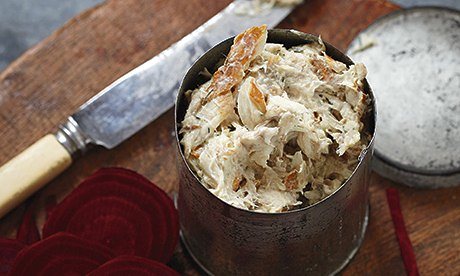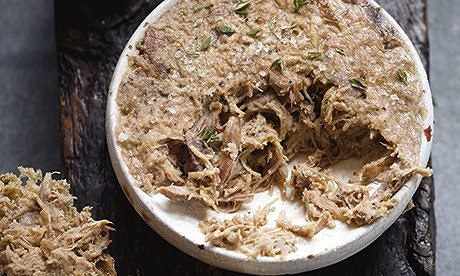Spread the word: Hugh Fearnley-Whittingstall's pâté, terrine and potted meat recipes
As long as you can peel a shallot, squeeze a lemon and switch on a food processor, you're well set to make your own pâté

Hugh Fearnley-Whittingstall's smoked mackerel pâté: 'It's dead easy and full of flavour.' Photograph: Colin Campbell for the Guardian
Pâtés, terrines and potted meats: ever given them a go? For some reason, they lie just outside the repertoire of a lot of keen home cooks; we think of them as restaurant fare, deli stuff, a bit too cheffy, or as the preserve of a past generation of farmers' wives or posh, country house cooks.
It's true they can be a bit time-consuming and technical. If you want to whip up a classic parfait de foies de volaille, say, you'd have to devote yourself to a bit of butter-clarifying, brandy-flambeeing and chicken-liver-sieving. But the pâtés I most enjoy eating are much simpler: coarse and chunky, earthy and gutsy. They're easy to make, too, and even easier to eat: just add toast and maybe a blob of fruity chutney. And here's the thing: with well-sourced ingredients, the pâté you make yourself (even the first one) may well be better than anything you've ever paid for.
Pâté just means paste in French. It amounts to not much more than meat or fish, minced, cooked and pressed. But it's the "not much more" that makes all the difference: the seasoning, the herbs (ideally fresh), the pinch of spice, the dash of booze; and the couple of days left to "ripen" in the fridge – important for those seasonings to marry and mingle and find their harmony.
There are variations on the pâté theme, but they are largely semantic; terrine makes a pâté sound posher, and it may be more constructed or layered, but that doesn't necessarily mean it's trickier to put together. "Potted" goes in the other direction, implying a cruder concoction of shredded or chopped meat (or fish) packed into a pot and bound with a little fat. Of course, the peasanty ring of something being "potted" gives it a reverse snobbery cache and trendiness. Potted things are popping up in pop-ups everywhere.
Like I said, easy. Not necessarily instant. Some pâtés take time, but that's generally marinating, baking and chilling time, not roll up your sleeves and cancel all appointments time. As long as you can peel a shallot, squeeze a lemon and switch on a food processor, you're pretty much laughing. In fact, you don't even need a food processor, as two of this week's recipes demonstrate. Some pâtés and terrines benefit from being pressed, and perhaps the greatest challenge there is finding something flat-based that fits neatly enough inside your chosen vessel. (If you're going to make pâtés regularly, then two identical moulds is a good investment.)
So here's a simple but luxurious smoky fish pâté, a delightfully peasanty potted duck and a pork terrine so easy and good that I'm betting you'll make it a staple.
Smoked mackerel pate
As well as being lighter and less creamy/cheesy than many mackerel pâtés, this is dead easy and full of flavour. Serves four as a starter.
- 250g hot-smoked mackerel fillet
- 25g unsalted butter
- ½ clove garlic, peeled and crushed
- Pinch of ground mace
- Pinch of cayenne pepper
- 2 tbsp crème fraîche
- A squeeze of lemon juice
- Freshly ground black pepper
- 1 small, raw beetroot, peeled and cut into matchsticks, to serve (optional)
Flake the mackerel into a large bowl, taking care to remove any skin and bones. Put the butter in a small pan with the garlic, mace and cayenne. Heat until the butter is just simmering, then pour over the fish. Add the crème fraîche, season generously with lemon juice and black pepper, and give it a good mix. The more you stir, the smoother the texture (you could, of course, blitz it in a food processor to make it even finer, but I prefer it quite coarse).
Serve on buttered wholemeal toast, ryebread or oatcakes, with the beetroot matchsticks alongside.
Simple pork and peppercorn terrine
A very easy terrine that slices into firm, flavour-packed slices, perfect for lunch with a chunk of bread and a dollop of pickle. Makes 10-12 slices.
- 300g rindless, boneless pork belly
- 250g smoked streaky bacon
- 200g free-range chicken livers (or very fresh pig's liver)
- 2 tbsp chopped sage
- 2 large banana shallots, peeled and chopped
- 1 clove garlic, peeled and finely chopped
- 50ml port
- 50g slightly stale white breadcrumbs
- 1-2 tbsp brined green peppercorns, drained
- Lard or oil, for greasing
- 4-5 bay leaves (optional)
Cut the pork belly into 2-3cm cubes. Roughly chop the bacon and livers. Combine all the meat with the sage, shallots and garlic, cover and leave overnight in the fridge.
Put the flavoured meat into a food processor and blitz to a coarse paste – you might find it easiest to do this in two batches; if you leave one batch quite coarse and the other finer, you'll get a good, firm and interesting texture in the finished terrine.
Transfer the meat to a large bowl, add the port, breadcrumbs and green peppercorns, and mix very thoroughly. Break off a small nugget of the mixture and fry it gently until cooked through. Taste it to assess the seasoning, then add salt and pepper to the raw pork mixture as necessary.
Heat the oven to 170C/335F/gas mark 3. Use a little lard or oil to grease a loaf tin (base measurement about 8 x 20cm), or similar sized terrine dish. Lay a few bay leaves, if using, along the base (ie, on what will be the top of the terrine). Pack the meat mixture into the tin, pressing it down firmly. Cover tightly with foil and place in a roasting tin. Pour in boiling water to come halfway up the sides of the loaf tin, and bake for an hour and a half to two hours, until the terrine has come away from the sides of the tin and a metal skewer pressed into its centre for a few moments comes out piping hot.
You now need to press the terrine as it cools, to give it a nice, firm texture. If you've used a loaf tin, place another loaf tin on top and fill that with weights such as cans of food, or even large pebbles. (Some terrine dishes come with their own ceramic platform that fits snugly over the terrine and that you can place weights on.) Don't go mad with the weights, or you'll squeeze out all the lovely meat juices. Leave the weighted terrine until completely cool, then remove the weights and refrigerate for 24 hours or so, for the flavours to develop.
To turn it out, run a small knife around the edges to release the terrine, then invert on to a board or plate (there will be savoury, jellied juices clinging to the terrine, which you can devour, or not, as you like). Slice thickly and serve with your favourite crusty bread, cornichons, a good chutney and perhaps a simple salad, such as lightly dressed chicory and fennel.
Potted duck

Hugh Fearnley-Whittingstall's potted duck: 'Rich and savoury.' Photograph: Colin Campbell for the Guardian
Rich and savoury, this is similar to classic duck rillettes, but much less fatty. Serves four as a starter.
- A splash of rapeseed or olive oil
- 2 free-range duck legs
- Sea salt and freshly ground black pepper
- 1 good sprig fresh thyme
- 3 bay leaves
- 1 whole head of garlic, cut in half horizontally
- 150ml white wine
- A good pinch of ground mixed spice
- A good pinch of ground mace
Heat the oven to 140C/285F/gas mark 1. Heat the oil in a frying pan over medium-high heat. Season the duck legs well, brown them all over in the hot pan, then transfer to a small roasting dish into which they will fit relatively snugly. Add the herbs and garlic, and pour over the wine and enough water just to immerse the meat. Cover the dish with a lid or with foil.
Cook for two to two and a half hours, until the duck is completely tender and can easily be pulled away from the bone. Remove the legs from the dish, then strain the cooking liquid into a jug and set aside.
When it's cool enough to handle, pull away the duck skin, then shred the flesh off the bones. Put this in a bowl, add plenty of salt and pepper, the pinches of spice and enough of the reserved cooking liquid just to bind the mix together – use as much of the fat off the top of the juices as you can, because it's this that helps bind the mix together. When you have a coarse, fairly loose pâté texture, taste and add more salt, pepper or spices as needed.
Pack the mixture into a bowl or four ramekins and pour a little more of the cooking juices on top. Refrigerate for at least a day, to allow the flavour to improve and the mix to set firm. Serve on oatcakes or brown toast, with a good chutney or onion marmalade.